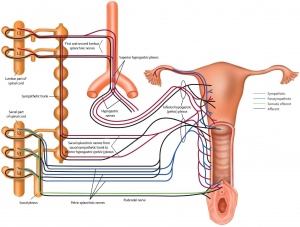Physical Disability and Sexual Dysfunction among Stroke Survivors
Introduction[edit | edit source]
Stroke remains a public health issue with attendant sequelae. Stroke is one of the leading causes of disability,[1] and this has a negative impact on stroke survivor’s quality of life[2] and their sexual quality of life. Over 50% of stroke survivor experience sexual dysfunction.[3]
Definition[edit | edit source]
Physical Disability can be defined as impairment in body structures and functions, activity limitations, and participation restrictions. International Classification of Functioning, Disability and Health (ICF).
Sexual Dysfunction can be defined as low sexual functioning as a result of “decline in libido and coital frequency for both genders, decline in vaginal lubrication and orgasm in females, and a decline in erection and ejaculation in males”[3].
Physical Disability[edit | edit source]
Disability is commonly reported among stroke survivors[2][4][5]. A third of stroke survivors have moderate to severe disabilities, and another third have mild disabilities[6]. About 95% of the stroke survivors had moderate or severe global disabilities[4]. This disability may hamper community reintegration and the participation of community-dwelling stroke survivors[7]. Focusing on reducing disability during rehabilitation will not only improve quality of life and reduce the burden of stroke but will also enhance self-reliance and productivity[1].
Assessment of Physical Disability[edit | edit source]
There are many assessment tools in form of outcome measure to assess physical disability among stroke survivors. Some are regional, general and condition specific. see Stroke Outcome Measures Overview.
Sexual Dysfunction[edit | edit source]
Sexuality is an important issue in post-stroke rehabilitation. Most stroke survivors reported low sexual functioning[8]. This dysfunction may be ‘‘a difficulty that occurs during the sexual response cycle that prevents the individual from experiencing satisfaction from sexual activity’’[9] or dysfunction characterized by pain following sexual intercourse[10].
Sexual dysfunctions among stroke survivors are multi-factorial in nature. The cause can be primary, secondary and tertiary in nature. The primary causes include: stroke directly affect sexual functioning e.g. “decline in libido and coital frequency for both genders, decline in vaginal lubrication and orgasm in females and in erection and ejaculation in males”[3]; and medical related sexual problems such as medication and premorbid medical conditions. Secondary causes include: sensorimotor problems which unable the stroke survivors to position themselves during sexual activity. Cognitive, behavioural and psychosocial adjustment issues formed the tertiary causes[3].
Assessment of Sexual Dysfunction[edit | edit source]
There are numerous outcome measure tools to assess sexual dysfunction in stroke survivors. The list are not limited to these: International Index of Erectile Function (IIEF), Derogatis Interview for Sexual Functioning (DISF), Changes in Sexual Functioning Short-Form (CSFQ-14), Sexual Function Questionnaire (SFQ), Arizona Sexual Experience Scale (ASEX), Sexual Satisfaction Scale for Women (SSS-W), Sexual Self-Perception and Adjustment Questionnaire (SSPAQ), etc[3][11].
Management[edit | edit source]
Management of physical disability[edit | edit source]
One of the goals of rehabilitation post stroke is to reduce disability to achieve maximum function and participation. There are several means of achieving this through physical therapy intervention. The role of physical activities cannot be over emphasized in improving function and reducing disability. see Stroke: The Role of Physical Activity and Physical Activity in Individuals with Disabilities.
Management of sexual dysfunction[3][edit | edit source]
- pharmacological interventions
- non-pharmacological interventions such as: mechanical devices (e.g. vacuum pumps, penile implants, penile prostheses and lubricating gels); psycho-educational interventions (e.g. counseling and psychotherapy); andphysical therapy (e.g physiotherapy for bed mobility)
- complementary medicine interventions
Physical Therapy management of sexual dysfunction[edit | edit source]
Couples may need to be thought bed mobility when one or both partners have hemiparesis after stroke[12]. Lying on hemiparetic side with adequate support with pillow and little bea nd have .been sswn to aid bed mobility and sexual activities. some sexual positions have been suggested helpful for stroke survivors.
Reference[edit | edit source]
- ↑ 1.0 1.1 Gbiri CA, Olawale OA, Isaac SO. Stroke Management: Informal caregivers’ burden and strain of caring for stroke survivors. Annals of Physical Rehabilitation Medicine 2015; 58: 98-103
- ↑ 2.0 2.1 Oyewole OO, Ogunlana MO, Gbiri CAO, Oritogun KS. Prevalence and impact of disability and sexual dysfunction on Health Related Quality of Life of Nigerian stroke survivors. Disability and Rehabilitation 2017; 39(20):2081-2086
- ↑ 3.0 3.1 3.2 3.3 3.4 3.5 Ng L, Sansom J, Zhang NY, Khan F. Interventions for sexual dysfunction following stroke. Cochrane Database of Systematic Reviews 2014, Issue 7. Art. No.: CD011189. DOI:10.1002/14651858.CD011189
- ↑ 4.0 4.1 Oyewole OO, Ogunlana MO, Oritogun KS, Gbiri CA. Post-Stroke Disability and Its Predictors among Nigerian Stroke Survivors. Disability and Health Journal 2016; 9(4):616-623
- ↑ Ju YW, Lee JS, Choi YA, Kim YH. Causes and trends of disabilities in community-dwelling stroke survivors: a population-based study. Brain & Neurorehabilitation. 2022 Mar;15(1).
- ↑ Skolarus LE, Burke JF. Towards an understanding of racial differences in post-stroke disability. Curr Epidemiol Rep 2015; 2:191–196
- ↑ Hamzat TK, Olaleye OA, Akinwumi OB. Functional ability, community reintegration and participation restriction among community dwelling female stroke survivors in Ibadan. Ethiop J Health Sci. 2014; 24:43-48
- ↑ Oyewole OO, Ogunlana MO, Gbiri CAO, Oritogun KS. Sexual Dysfunction in a Nigerian Stroke Cohort: A Comparative Cross-Sectional Study. Sex Disabil. 2017; 35(3):341-351
- ↑ Chen C-H, Lin Y-C, Chiu L-H, Chu Y-H, Ruan F-F, Liu W-M, Wang P-H. Female sexual dysfunction: definition, classification, and debates. Taiwan J. Obstet. Gynecol. 2013; 52, 3–7
- ↑ McCool ME, Theurich MA, Apfelbacher C. https://systematicreviewsjournal.biomedcentral.com/articles/10.1186/2046-4053-3-75. Syst. Rev. 2014; 3, 75
- ↑ DeRogatis LR. Assessment of sexual function/dysfunction via patient reported outcomes. International Journal of Impotence Research 2008; 20, 35–44; doi:10.1038/sj.ijir.3901591
- ↑ Kautz DD, Van Horn ER. Sex and Intimacy after Stroke: Recommendations from the 2013 AHA Consensus Document. Int J Phys Med Rehabil 2014; S3: 003. doi:10.4172/2329-9096.S3-003







